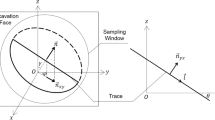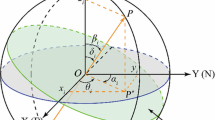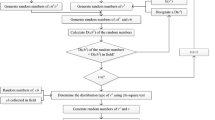Abstract
Fracture diameter is an important factor to evaluate rock mass quality accurately, while there is a lack of effective methods to estimate three-dimensional diameter of multiple groups of fractures by observation data. The study proposes a density-based multi-level clustering method to cluster the two-dimensional outcrop fracture data according to both fracture orientation and size. The method considers the five types of boundary problems of the orientation domains and is applied to estimate diameter distributions of multiple fracture sets by clustering fracture orientation, merging misclustered fracture clusters, and classifying fractures based on the estimated fracture size. The K-means clustering by fast search and find of density peaks is established to intuitively determine the centers of fracture sets and the independent fractures, and assign the fracture samples to the appropriate clusters. The orientation cluster differentiation coefficient (OCDC) is defined to derive the subcluster merging conditions and center merging function for the fracture sets near the boundaries of the orientation domains, and the empirical formula of OCDC versus the pooled standard deviations of orientation samples is derived. A simplified calculation of the most probable diameter of a trace is derived according to the estimation formula of diameter standard deviation versus trace length. The multi-level clustering method is verified and discussed by Monte Carlo simulation. The proposed method is applied to an excavation face from Sejilashan tunnel. The result indicates that the clustered outcrop fractures are similar to the field observation, and the estimated three-dimensional diameter distributions of multiple fracture sets are in good agreement with the geological survey.
















Similar content being viewed by others
Data availability
Not applicable.
References
Zhang Q, Huang X, Zhu H et al (2019) Quantitative assessments of the correlations between rock mass rating (RMR) and geological strength index (GSI). Tunn Undergr Sp Technol 83:73–81. https://doi.org/10.1016/j.tust.2018.09.015
Zhu H, Zuo Y, Li X et al (2014) Estimation of the fracture diameter distributions using the maximum entropy principle. Int J Rock Mech Min Sci 72:127–137. https://doi.org/10.1016/j.ijrmms.2014.09.006
Lapointe PR, Wallmann PC, Dershowitz WS (1993) Stochastic estimation of fracture size through simulated sampling. Int J Rock Mech Min Sci 30(7):1611–1617. https://doi.org/10.1016/0148-9062(93)90165-a
Kulatilake PHSW, Wathugala DN, Stephansson O (1993) Stochastic three dimensional joint size, intensity and system modelling and a validation to an area in stripa mine, Sweden. Soils Found 33(1):55–70. https://doi.org/10.3208/sandf1972.33.55
Zhang LY, Einstein HH (2000) Estimating the intensity of rock discontinuities. Int J Rock Mech Min Sci 37(5):819–837. https://doi.org/10.1016/s1365-1609(00)00022-8
Jimenez-Rodriguez R, Sitar N (2006) Inference of discontinuity trace length distributions using statistical graphical models. Int J Rock Mech Min Sci 43(6):877–893. https://doi.org/10.1016/j.ijrmms.2005.12.008
Zhang L, Einstein HH (1998) Estimating the mean trace length of rock discontinuities. Rock Mech Rock Eng 31(4):217–235. https://doi.org/10.1007/s006030050022
Pahl PJ (1981) Estimating the mean length of discontinuity traces. Int J Rock Mech Min Sci 18(3):221–228. https://doi.org/10.1016/0148-9062(81)90976-1
Kulatilake P, Wu TH (1984) Estimation of mean trace length of discontinuities. Rock Mech Rock Eng 17(4):215–232. https://doi.org/10.1007/bf01032335
Mauldon M (1998) Estimating mean fracture trace length and density from observations in convex windows. Rock Mech Rock Eng 31(4):201–216. https://doi.org/10.1007/s006030050021
Villaescusa E, Brown ET (1992) Maximum-likelihood-estimation of joint size from trace length measurements. Rock Mech Rock Eng 25(2):67–87. https://doi.org/10.1007/bf01040513
Song JJ, Lee CI (2001) Estimation of joint length distribution using window sampling. Int J Rock Mech Min Sci 38(4):519–528. https://doi.org/10.1016/s1365-1609(01)00018-1
Tonon F, Chen S (2007) Closed-form and numerical solutions for the probability distribution function of fracture diameters. Int J Rock Mech Min Sci 44(3):332–350. https://doi.org/10.1016/j.ijrmms.2006.07.013
Zhang Q, Wang X, He L et al (2021) Estimation of fracture orientation distributions from a sampling window based on geometric probabilistic method. Rock Mech Rock Eng 54(6):3051–3075. https://doi.org/10.1007/s00603-021-02431-0
Zhan J, Chen J, Xu P et al (2017) Automatic identification of rock fracture sets using finite mixture models. Math Geosci 49(8):1021–1056. https://doi.org/10.1007/s11004-017-9702-1
Han X, Chen J, Wang Q et al (2016) A 3D fracture network model for the undisturbed rock mass at the songta dam site based on small samples. Rock Mech Rock Eng 49(2):611–619. https://doi.org/10.1007/10.1007/s00603-015-0747-5
Kulatilake P (1986) Bivariate normal-distribution fitting on discontinuity orientation clusters. Math Geol 18(2):181–195. https://doi.org/10.1007/bf00898282
Zhang W, Chen JP, Liu C et al (2012) Determination of geometrical and structural representative volume elements at the baihetan dam site. Rock Mech Rock Eng 45(3):409–419. https://doi.org/10.1007/s00603-011-0191-0
Zheng J, Deng J, Yang X et al (2014) An improved monte carlo simulation method for discontinuity orientations based on fisher distribution and its program implementation. Comput Geotech 61:266–276. https://doi.org/10.1016/j.compgeo.2014.06.006
Shanley RJ, Mahtab MA (1976) Delineation and analysis of clusters in orientation data. J Int Assoc Math Geol 8(1):9–23. https://doi.org/10.1007/bf01039681
Zhan J, Xu P, Chen J et al (2017) Comprehensive characterization and clustering of orientation data: a case study from the Songta dam site, China. Eng Geol 225:3–18. https://doi.org/10.1016/j.enggeo.2017.01.010
Ma GW, Xu ZH, Zhang W et al (2015) An enriched K-means clustering method for grouping fractures with meliorated initial centers. Arab J Geosci 8(4):1881–1893. https://doi.org/10.1007/s12517-014-1379-x
Li YY, Wang Q, Chen JP et al (2015) K-means algorithm based on particle swarm optimization for the identification of rock discontinuity sets. Rock Mech Rock Eng 48(1):375–385. https://doi.org/10.1007/s00603-014-0569-x
Tokhmechi B, Memarian H, Moshiri B et al (2011) Investigating the validity of conventional joint set clustering methods. Eng Geol 118(3–4):75–81. https://doi.org/10.1016/j.enggeo.2011.01.002
Xu LM, Chen JP, Wang Q et al (2013) Fuzzy C-means cluster analysis based on mutative scale chaos optimization algorithm for the grouping of discontinuity set. Rock Mech Rock Eng 46(1):189–198. https://doi.org/10.1007/s00603-012-0244-z
Xu W, Zhang Y, Li X et al (2020) Extraction and statistics of discontinuity orientation and trace length from typical fractured rock mass: a case study of the Xinchang underground research laboratory site, China. Eng Geol. https://doi.org/10.1016/j.enggeo.2020.105553
Cui X, Yan EC (2020) A clustering algorithm based on differential evolution for the identification of rock discontinuity sets. Int J Rock Mech Min Sci. https://doi.org/10.1016/j.ijrmms.2019.104181
Cui XJ, Yan EC (2020) Fuzzy C-means cluster analysis based on variable length string genetic algorithm for the grouping of rock discontinuity sets. KSCE J Civ Eng 24(11):3237–3246. https://doi.org/10.1007/s12205-020-2188-2
Song SY, Wang Q, Chen JP et al (2017) Fuzzy C-means clustering analysis based on quantum particle swarm optimization algorithm for the grouping of rock discontinuity sets. Ksce J Civ Eng 21(4):1115–1122. https://doi.org/10.1007/s12205-016-1223-9
Jimenez-Rodriguez R, Sitar N (2006) A spectral method for clustering of rock discontinuity sets. Int J Rock Mech Min Sci 43(7):1052–1061. https://doi.org/10.1016/j.ijrmms.2006.02.003
Yamaji A, Sato K (2011) Clustering of fracture orientations using a mixed Bingham distribution and its application to paleostress analysis from dike or vein orientations. J Struct Geol 33(7):1148–1157. https://doi.org/10.1016/j.jsg.2011.05.006
Peel D, Whiten WJ, Mclachlan GJ (2001) Fitting mixtures of Kent distributions to aid in joint set identification. J Am Stat Assoc 96(453):56–63. https://doi.org/10.1198/016214501750332974
Liu T, Zheng J, Deng J (2021) A new iteration clustering method for rock discontinuity sets considering discontinuity trace lengths and orientations. Bull Eng Geol Environ 80(1):413–428. https://doi.org/10.1007/s10064-020-01921-9
Zhang P, Li J, Yang X et al (2018) Semi-automatic extraction of rock discontinuities from point clouds using the ISODATA clustering algorithm and deviation from mean elevation. Int J Rock Mech Min Sci 110:76–87. https://doi.org/10.1016/j.ijrmms.2018.07.009
Hammah RE, Curran JH (1998) Fuzzy cluster algorithm for the automatic identification of joint sets. Int J Rock Mech Min Sci 35(7):889–905. https://doi.org/10.1016/s0148-9062(98)00011-4
Sirat M, Talbot CJ (2001) Application of artificial neural networks to fracture analysis at the Aspo HRL, Sweden: fracture sets classificatio. Int J Rock Mech Min Sci 38(5):621–639. https://doi.org/10.1016/s1365-1609(01)00030-2
Zhou W, Maerz NH (2002) Implementation of multivariate clustering methods for characterizing discontinuities data from scanlines and oriented boreholes. Comput Geosci 28(7):827–839. https://doi.org/10.1016/s0098-3004(01)00111-x
Terzaghi RD (1965) Sources of error in joint surveys. Geotech 15(3):287–304. https://doi.org/10.1680/geot.1965.15.3.287
Rodriguez A, Laio A (2014) Clustering by fast search and find of density peaks. Sci 344(6191):1492–1496. https://doi.org/10.1126/science.1242072
Warburton PM (1980) A stereological interpretation of joint trace data. Int J Rock Mech Min Sci 17(4):181–190. https://doi.org/10.1016/0148-9062(80)91084-0
Lyman GJ (2003) Stereological and other methods applied to rock joint size estimation - Does Crofton’s theorem apply? Math Geol 35(1):9–23. https://doi.org/10.1023/a:1022326927389
Chen J, Zhu H, Li X (2016) Automatic extraction of discontinuity orientation from rock mass surface 3D point cloud. Comput Geosci 95:18–31. https://doi.org/10.1016/j.cageo.2016.06.015
Li X, Chen J, Zhu H (2016) A new method for automated discontinuity trace mapping on rock mass 3D surface model. Comput Geosci 89:118–131. https://doi.org/10.1016/j.cageo.2015.12.010
Zhang K, Wu W, Zhu H et al (2020) A modified method of discontinuity trace mapping using three-dimensional point clouds of rock mass surfaces. J Rock Mech Geotech Eng 12(3):571–586. https://doi.org/10.1016/j.jrmge.2019.10.006
Cai W, Zhu H, Liang W (2022) Three-dimensional tunnel face extrusion and reinforcement effects of underground excavations in deep rock masses. Int J Rock Mech Min Sci 150:104999. https://doi.org/10.1016/j.ijrmms.2021.104999
Acknowledgements
The authors would like to acknowledge the financial support. This study is supported partially by the National Natural Science Foundation of China (41972277 and 41602300), Special Fund for Basic Research on Scientific Instruments of the National Natural Science Foundation of China (41827807), State Key Laboratory for GeoMechanics and Deep Underground Engineering, China University of Mining and Technology (SKLGDUEK2006), and Sichuan Railway Investment Group Co., Ltd. (SRIG2019GG0004).
Funding
This study is supported partially by the National Natural Science Foundation of China (41972277 and 41602300), Special Fund for Basic Research on Scientific Instruments of the National Natural Science Foundation of China (41827807), State Key Laboratory for GeoMechanics and Deep Underground Engineering, China University of Mining and Technology (SKLGDUEK2006), and Sichuan Railway Investment Group Co., Ltd. (SRIG2019GG0004).
Author information
Authors and Affiliations
Corresponding author
Ethics declarations
Conflict of interest
No conflict of interest exists in this manuscript.
Additional information
Publisher's Note
Springer Nature remains neutral with regard to jurisdictional claims in published maps and institutional affiliations.
Rights and permissions
Springer Nature or its licensor (e.g. a society or other partner) holds exclusive rights to this article under a publishing agreement with the author(s) or other rightsholder(s); author self-archiving of the accepted manuscript version of this article is solely governed by the terms of such publishing agreement and applicable law.
About this article
Cite this article
Zhang, Q., Wang, X., Zhu, H. et al. Estimation of three-dimensional diameter distributions of multiple fracture sets clustered by a multi-level clustering method. Acta Geotech. 18, 4429–4452 (2023). https://doi.org/10.1007/s11440-023-01801-y
Received:
Accepted:
Published:
Issue Date:
DOI: https://doi.org/10.1007/s11440-023-01801-y




